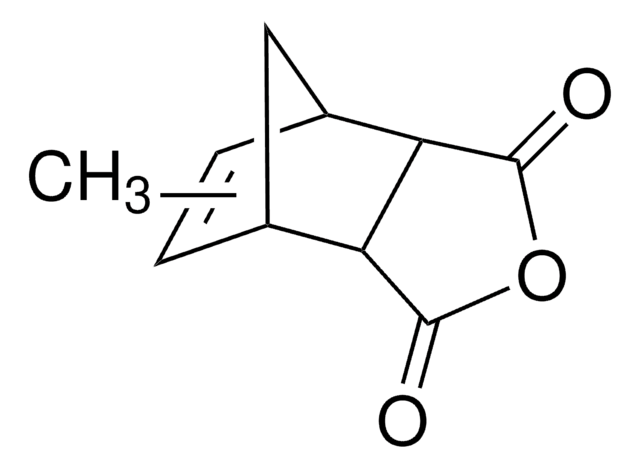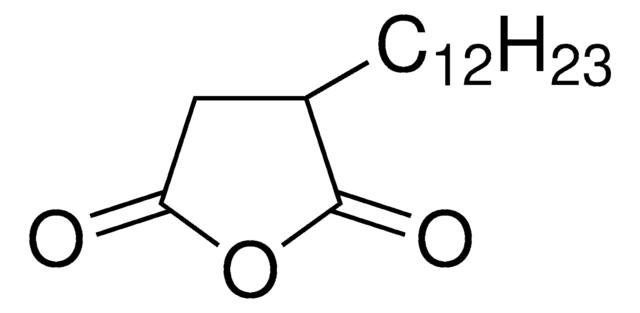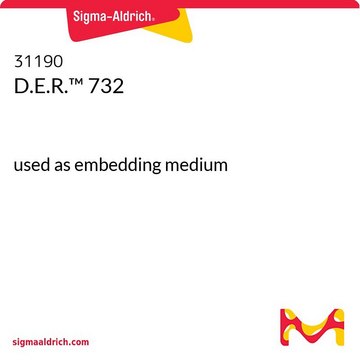Wszystkie zdjęcia(1)
Key Documents
45359
Epoxy Embedding Medium kit
embedding resin for electron microscopy
Synonim(y):
Epon™ substitute embedding medium kit
Zaloguj sięWyświetlanie cen organizacyjnych i kontraktowych
About This Item
Kod UNSPSC:
12171500
NACRES:
NA.47
Polecane produkty
Opis ogólny
The Epoxy Embedding Medium Kit is a very widely used embedding medium for electron microscopy. The embedding formulation originally published by Luft (1961) is excellent for both plant and animal tissues. Due to the low viscosity of the resin, it penetrates the tissue specimen faster than Araldite and other polymers. It hardens easily and uniformly at low temperatures with the addition of dodecenylsuccinic anhydride (DDSA), methyl nadic anhydride (MNA), and the accelerator 2,4,6-tris(dimethylaminomethyl)phenol (DMP-30). Slight shrinkage may occur during curing. This kit is useful for embedding a variety of tissues as a wide range of hardness can be obtained with this resin to suit a specific tissue type by using two different anhydride curing agents (DDSA and MNA).
Zastosowanie
Epoxy Embedding Medium Kit has been used in the following applications:
- to study the role of NDRG2, an essential colonic epithelial barrier regulator, in gut homeostasis maintenance and colitis-associated tumor development
- to study the interaction of polymer scaffold nanofibers with growing cells
- to study the morphological characterization of postembryonic development of blood–spleen barrier in ducks
- to understand the role of NOD1/NOD2 receptors in Fusobacterium nucleatum-mediated neutrophil extracellular traps
Cechy i korzyści
- Excellent medium for embedding a wide variety of tissues, including both plant and animal.
- Facilitates rapid embedding (less than 3 hours).
- Low viscosity facilitates rapid tissue penetration.
- Desirable hardness is easy to obtain to suit a specific tissue type.
Komponenty
45345 Epoxy Embedding Medium 2x250 ml
45347 Hardener MNA 250 ml
45346 Hardener DDSA 250 ml
45348 Accelerator DMP 30 250 ml
45347 Hardener MNA 250 ml
45346 Hardener DDSA 250 ml
45348 Accelerator DMP 30 250 ml
Informacje prawne
Epon is a trademark of Hexion, Inc.
This page may contain text that has been machine translated.
produkt powiązany
Numer produktu
Opis
Cennik
Hasło ostrzegawcze
Danger
Zwroty wskazujące rodzaj zagrożenia
Zwroty wskazujące środki ostrożności
Klasyfikacja zagrożeń
Acute Tox. 4 Oral - Aquatic Chronic 4 - Eye Dam. 1 - Resp. Sens. 1 - Skin Corr. 1B - Skin Sens. 1 - STOT SE 3
Organy docelowe
Respiratory system
Kod klasy składowania
8A - Combustible corrosive hazardous materials
Temperatura zapłonu (°F)
275.0 °F
Temperatura zapłonu (°C)
135 °C
Certyfikaty analizy (CoA)
Poszukaj Certyfikaty analizy (CoA), wpisując numer partii/serii produktów. Numery serii i partii można znaleźć na etykiecie produktu po słowach „seria” lub „partia”.
Masz już ten produkt?
Dokumenty związane z niedawno zakupionymi produktami zostały zamieszczone w Bibliotece dokumentów.
Klienci oglądali również te produkty
A Sawaguchi et al.
Journal of microscopy, 234(2), 113-117 (2009-04-29)
The goal of specimen preparation for transmission electron microscopy is to obtain high-quality ultra-thin sections with which we can correlate cellular structure to physiological function. In this study, we newly developed a capsule-supporting ring that can be useful for resin
Emma Cantisani et al.
The Analyst, 144(7), 2375-2386 (2019-02-26)
Red stains are a common discolouration on stone cultural heritage all over the world. These are very difficult to remove and little is known about the reddish pigmentation. Numerous red stains were mapped on the Baptistery of San Giovanni in
Kunio Nagashima et al.
Methods in molecular biology (Clifton, N.J.), 697, 83-91 (2010-12-01)
This chapter outlines the procedures for ex vivo TEM preparation of nanoparticle-containing tissue or cell culture samples using an epoxy resin embedding method. The purpose of this procedure is to preserve the structure of tissue in a hardened epoxy block
Konstantin E Mochalov et al.
Ultramicroscopy, 182, 118-123 (2017-07-04)
In the past decade correlative microscopy, which combines the potentials of different types of high-resolution microscopies with a variety of optical microspectroscopy techniques, has been attracting increasing attention in material science and biological research. One of outstanding solutions in this
Investigation of the effects of semaphorin 3A on new bone formation in a rat calvarial defect model.
Sevinç Kenan et al.
Journal of cranio-maxillo-facial surgery : official publication of the European Association for Cranio-Maxillo-Facial Surgery, 47(3), 473-483 (2019-01-09)
This study investigates the effects of semaphorin 3A on new bone formation in an experimental rat model. Cortical bone defects, 5 mm, were created in the calvaria of 40 Wistar rats, which were then separated into three groups: empty defect (control)
Nasz zespół naukowców ma doświadczenie we wszystkich obszarach badań, w tym w naukach przyrodniczych, materiałoznawstwie, syntezie chemicznej, chromatografii, analityce i wielu innych dziedzinach.
Skontaktuj się z zespołem ds. pomocy technicznej












